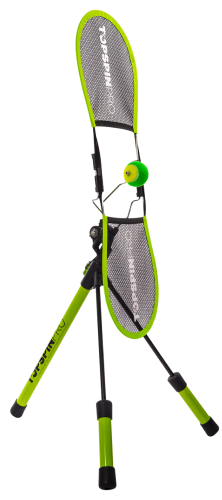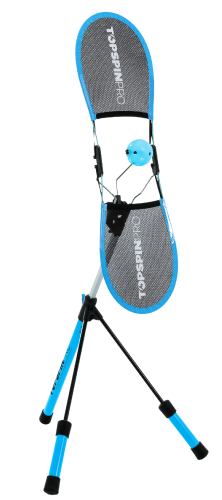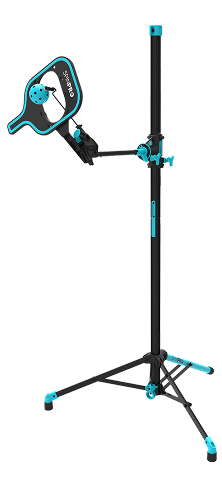In this edition – Australian Open, Single shot focus, Forehand progressions, Using the legs, front-view of the serve and our Parting Shot is from Panama.

2 weeks ago 72 players arriving in Melbourne were forced to isolate in hotel rooms around the city. The next day videos of pros hitting balls against their mattresses, timelapse clips of workouts and even one tale of a mouse in a player’s room emerged all over the web. We snapped into action and sent TopspinPros to 10 of the more prolific posters, offering to add a little variety to there in-room-training-regimes and garner a little publicity in the process.Problem was we had no idea which players were in which hotels! Luckily hotel chains like to unique yet consistent carpet designs. Thanks to Tripadvisor guest photos I quickly identified the hotels of 10 players and got shipping. Ultimately only 5 made it to players rooms (Covid meant reception needed various forms completed). One of those players stood out. Ellen Perez, currently ranked 47 in the world. In ‘true Aussie’ fashion she generously posted a few clips – a playful one challenging Heather Watson and suggesting the TopspinPro was essential to her Australian Open bid this year and another one training hard. I promised to find her some interesting tennis fans from around the world. Please follow her and let’s see if she makes history!

My second Lockdown Story is closer to home. I have found myself in an extremely privileged position – we recently moved into a house with a tennis court. Lockdown has meant I have been able to take advantage of it in an interesting way. My 9-year-old son Jack has a short attention span, no real interest in tennis and struggles to accept advice from me 😉 Not the ideal candidate for me to coach! But as luck would have it he chose tennis as his daily exercise between online lessons and gets a real thrill from hitting it hard.I decided to try some theory from Archie Dan Smith’s book on Muscle Memory. Conventional wisdom and common coaching practise suggests each lesson comprises time spend on the forehand, then the backhand, perhaps some approach shots, volleys, overhead and then 10 minutes on the serve. Limited progress is made on each and much is lost between lessons. Archie Dan Smith says work on one stroke. So I have focused exclusively on his forehand. And it’s getting better quickly. With the mastery has come enjoyment. We’ve also done a little work on his serve. If you can serve and have a forehand you can play tennis. I’m not trying to create a world champion. I just want him to enjoy himself and perhaps one day get a date 🙂
Forehand Progressions for Juniors
Speaking of 9-year-old and forehands, here is a fantastic set of forehand progressions Tamas Bogyo demonstrates with his 9-year-old player.
Step 1: Feel the load
Step 2: Avoid the big backswing
Step 3: TopspinPro for wrist movement
Step 4: Showtime
Tamas suggests 6 balls at each station.
Using the legs with the TopspinPro
I recently received a question from a customer about using the legs when practising with the TopspinPro. Is it best to try to remain stationary with the feet planted or to use the entire motion of the legs to simulate play?
While you’re working on the ingraining the correct hand action for developing topspin, it is best to remain stationary. Once that it mastered progress to using the legs. And finally, start in the ready position so you can work on finding the correct spacing between you and the ball at contact.
Leg drive is exceptionally important in tennis so it is worth talking about it briefly. It’s the force of us pushing off the ground which we are ultimately able to convert into a powerful hand action via the kinetic chain. Legs, hips, shoulders, arms and finally the wrist. But it is a mistake to suggest it is important for topspin. The only thing that matters for topspin is racket head speed from below the ball to above the ball. And the best way to generate that is long-axis rotation of the arm (or pronation) combined with ulnar to radial deviation of the wrist/hand. That’s it. If you want to know how much the legs help on their own keep your racket horizontal (parallel to the ground in a fixed position. And then drive up with your legs. You’ll notice your racket moves up about 20 cm. And it’s an order of magnitude slower than what you can achieve with your arm and wrist.Patrick Mouratoglou explains it here.”A lot of people think the legs are for topspin. But it’s not true. What creates topspin is your hand work.”Many misconstrued this post in 2 ways:1. He never said the legs weren’t important. The legs are crucial – they are for power.2. People said ‘you’re wrong – the pro’s all lift’. True – the pro’s all lift, but not to generate topspin.

And if you need further proof, watch this Roger Federer clip. His leg drive suspends well BEFORE contact. He does not rise through the shot – look at the level of his head. Almost his entire body, with the exception of his arm, doesn’t move during the stroke. The kinetic chain has done its job and because he’s so loose the racket head is almost effortlessly flung at the ball.

A Picture is a 1000 Words

Extremely helpful image. This is a serve with a LOT of spin on hit. Have a look at the two rackets either side of contact. The racket is NOT travelling in the direction of the ball. It’s travelling almost parallel to the baseline.More illuminating photography from the folks at Tennis Analytics
Parting Shot

Three young men from Panama debating the merits of the topspin forehand…
Enjoyed this article?
Be sure to sign up for our newsletter and we'll keep you up to date about new posts


